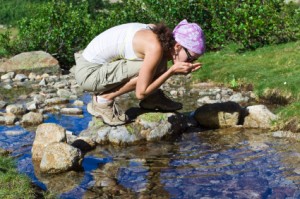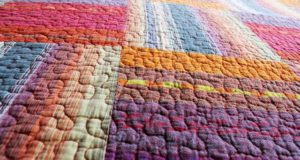We have all seen the story played out in the news. The headline reads “Couple found alive after four days lost in the wilderness,” and the story will go on to tell the tale of how they stayed warm and what, if anything, they ate and drank. Usually buried somewhere in the text you will see something along the lines of, “they are currently in the hospital recovering from dehydration.”
Someday you may find yourself in the wilderness, the real wilderness, with no modern conveniences. Most people who plan to travel into the wilderness bring their own water purifying equipment, or pack their water in with them. But what happens when you find yourself stranded unprepared in a wilderness setting? How important is water to your survival?
Dr. Ron Hood, of Hoods Woods fame, states in his famous Rule of Threes that a person can live three days without water. Water is a much more immediate need in a wilderness situation than is food. Your body is more than three quarters fluids, and it needs to remain hydrated in order to function properly. Dehydration can cloud your judgment, and clouded judgment is the last thing you want in a wilderness survival situation.
A Water Filter So Small and Lightweight You Can Easily Carry It In Your Pocket…
Sources of Water
 Finding water in the wilderness may be as simple as falling into a creek or as difficult as building a solar still. There are literally hundreds of ways to find water; the key will be your knowledge of how to get it and make it potable. Here are a few.
Finding water in the wilderness may be as simple as falling into a creek or as difficult as building a solar still. There are literally hundreds of ways to find water; the key will be your knowledge of how to get it and make it potable. Here are a few.
Running Water
The obvious source of water will be rivers or streams that you may stumble across. Look in the bottom of valleys or gullies. Moving water will be one of your best choices for a water supply in the wilderness. Aeration is a natural process of cleaning water of some contaminants. Fast moving water is naturally aerated by getting splashed around over rocks and other obstacles. While it should still be treated if possible, moving water will be one of the cleaner sources of water.
Springs
A spring can be difficult to locate, but the payoff is sometimes very good water. You will need to look for areas with thicker or darker green vegetation. If you can get a high vantage point, such as a ridge, it will make spotting likely areas easier. Springs may not flow on the surface; they may look like only a wet spot. You will have to move some rocks or dig a hole to get water from a subsurface spring. Like running water, springs are one of the safer sources of water, but again if possible, treat it before consumption.
Standing Water
Lakes and ponds are another obvious source of wilderness water. Generally speaking, lake water is on the safer side of the drinking scale. Swamps and bogs, on the other hand, should be avoided if at all possible. Puddles (the fresher, the better) can also be a good source, especially ones formed in indentations of rocks.
Rain, Snow, and Dew
Falling rain and snow are an excellent source of water. If you are out of an area of acid rain, it should be potable as it falls. Rain can be caught in containers, and if you have extra clothing, they can be laid out and wrung into containers as they become soaked. Similarly, early morning dew can be mopped up with cloth and then wrung into a container.
Snow should be eaten with care; if possible, it should be melted before you consume it. Snow takes energy to melt, and if you are in a survival situation, energy is not something you want to waste. It also lowers your body temperature, and if it’s cold enough to snow, you will have to be aware of the possibility of hypothermia. Older snow lying on the ground is subject to contaminants in just the same way water is.
Other Places to Look
Look under rock ledges and try digging in dry creek beds. There are certain plants that can provide water. The inside of a cactus can be eaten, and sap from some trees can be utilized at certain times of the year when it is running well.
Manufactured Water
There are at least two ways you can make your own water in the wilderness. Neither can be done with primitive means, but if you have a couple sandwich bags or a plastic sheet, you can get water from nothing.
Solar Still
A hole is dug in the ground between two and three feet wide and about two feet deep. A container is placed in the bottom to catch the water; the hole is covered loosely with plastic sheeting. The edges of the sheet are weighted down with rocks and a small stone is placed on the sheet just above the container in the hole. This forms an inverted tepee with the point directed at the container in the bottom of the hole.
The sun heats the hole and evaporated water condenses on the plastic sheet, which then runs down and drips into the container. This provides small quantities of water, but is better than nothing when you need it.
Transpiration
Transpiration is the loss of water vapor by plants. If you have some plastic bags, they can be put over tree branches (be sure there are a lot of leaves) or leafy plants. When the sun hits the bag, it acts like the solar still, forcing water out of the leaves. Bags will have to be moved often since a fresh set of leaves will put out more water to begin with than later on. Be sure not to use poisonous plants like poison ivy since the volatile oils may be evaporated also.
Primitive Methods for Cleaning Your Water
Now that you have located water, you will want to clean it in some way. Nothing you can do in the wild will make your water absolutely safe to drink. But you can reduce your risk considerably. Always use as many methods of cleaning as possible, since each one works slightly differently.
Natural pollutants will include:
- Sediment: chunks of things in your water, which can be organic or inorganic
- Pathogens: viruses and bacteria that can make you sick
- Critters: microscopic bugs like giardia
- Pollution: heavy metals, pesticides, etc.
Start by filtering your water as well as you can. Several layers of cloth will work ,or you can make a primitive filter by alternating layers of grass and sand over a grid of sticks, covered with a layer of cloth. In a pinch, you can use your sock. Water can also be cleaned by just letting it set for a time. Sediments and other contaminants will settle to the bottom or float to the top.
If you are using a lake or stream as your water source, a good place to start the filtration process is to dig a hole a few feet away from the body of water. Let water seep into the hole and settle, this way you are using the earth itself as a filter.
Charcoal (charred wood) can be added to your water and allowed to soak. This will add another layer of protection to your water source. While not as efficient as an activated charcoal filter, the charcoal soaks up pollutants, which removes them from your water. The soaking process takes time, but if you are worried about chemicals in your water, you really should take this step. After a good soak, filter out the charcoal through a cloth.
Finally, if at all possible, boil your water. Boiling kills all the little critters and pathogens that can make you sick and ruin your wilderness survival outing. If you have a fire and container, you are set to go. If you don’t have a container, you can still boil water.
Water can be boiled in a leaf or bark container. The water keeps the container from burning up. You will have to decide if you have the proper materials to try this in your situation. You can also boil water in a hole in the ground. If you have dug out a water source, you can heat rocks and toss them in the hole. Eventually the water will boil if you keep at it. Then let it settle over night, and you will have safe water to drink.
Methods to boil water have yet to be discovered if there is no access to fire. You will just have to make do with the best-filtered water you can get.
Miscellaneous Wilderness Water Tips
Many people have died of dehydration with water left in their canteen, so drink when you are thirsty.
Do not drink blood, urine, or salt water, given that each contains impurities that will cause your body to lose more water getting rid of the impurities than you can get from drinking them in the first place.
Eat sparingly; if you have no water, don’t eat at all. Digestion uses water, and the rule of three states that if necessary, you can live up to three weeks without food.
Avoid drinking water running out of mine shafts. These sources are common in some areas, but the water may contain dangerous amounts of heavy metals.
If you have no choice, drink what water you can find; better to be alive with a chance of being sick than to be dead from dehydration.
If you can find water and make it potable, you have a much better chance of making it home from your unplanned wilderness experience.
 Off The Grid News Better Ideas For Off The Grid Living
Off The Grid News Better Ideas For Off The Grid Living




